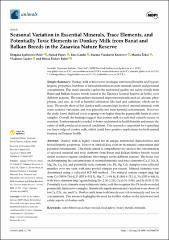Seasonal Variation in Essential Minerals, Trace Elements, and Potentially Toxic Elements in Donkey Milk from Banat and Balkan Breeds in the Zasavica Nature Reserve

View/
Date
2025Author
Ljubojević Pelić, Dragana
Popov, Nenad
Gardić, Ema
Vidaković Knežević, Suzana
Žekić, Marina
Gajdov, Vladimir
Živkov-Baloš, Milica
Metadata
Show full item recordAbstract
Donkey milk is highly valued for its unique nutritional characteristics and hypoallergenic properties. However, limited data exist on its mineral composition and potential contaminants. This study aimed to comprehensively analyze the concentration of selected essential and toxic elements from Banat and Balkan donkey breeds reared under extensive organic conditions (free-range) across different seasons. The focus was on determining the concentrations of essential minerals and trace elements (Ca, P, Na, K, Mg, Zn, Cu, Se), and potentially toxic elements (As, Pb, Hg, Cd). Samples were collected monthly over one year, with nine pooled samples per season. Mineral elements were determined using a validated ICP-MS method. The mineral content ranges (mg/kg) were Ca (588.9–744.4), P (355.6–533.3), Mg (71.1–84.4), K (444.4–711.1), Na (355.6–444.4), with trace elements (mg/kg) including Zn (2.06–2.21), Cu (0.31–0.68), and Se (0.02–0.05). Potentially toxic elements were within safe limits, with the exception that Pb levels exceeded permissible limits in two samples. Statistically significant seasonal variations were observed for Ca, P, K, As, and Cu. Donkey milk from both breeds was rich in minerals and low in contaminants. This research highlights the need for further studies on the nutritional and safety aspects of donkey milk.
